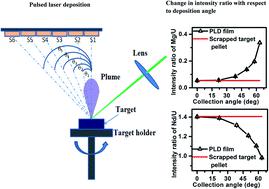当前位置:
X-MOL 学术
›
J. Anal. At. Spectrom.
›
论文详情
Our official English website, www.x-mol.net, welcomes your feedback! (Note: you will need to create a separate account there.)
Effect of mass distribution and collection angle in pulsed laser deposited films – a sampling method for chemical characterization of spent nuclear fuel
Journal of Analytical Atomic Spectrometry ( IF 3.4 ) Pub Date : 2020-09-10 , DOI: 10.1039/d0ja00316f U. K. Maity 1, 2, 2, 3, 4 , P. Manoravi 2, 3, 4 , M. Joseph 1, 2, 2, 3, 5 , N. Sivaraman 1, 2, 2, 3, 4
Journal of Analytical Atomic Spectrometry ( IF 3.4 ) Pub Date : 2020-09-10 , DOI: 10.1039/d0ja00316f U. K. Maity 1, 2, 2, 3, 4 , P. Manoravi 2, 3, 4 , M. Joseph 1, 2, 2, 3, 5 , N. Sivaraman 1, 2, 2, 3, 4
Affiliation

|
Pulsed laser deposition (PLD) can be used as a sampling tool for chemical characterization of irradiated nuclear fuel when coupled with mass spectrometry analysis. The quantity of sample obtained by PLD is very small (typically a few nanograms), thereby reducing the radiation exposure to a considerable extent, but still provides the spatial profile of the irradiated pellet accurately (uncertainty error ∼1%) compared to the conventional gamma spectrometry method (error >5%), which is traditionally employed. Since PLD involves deposition of a laser ablated plume on a substrate, the mass distribution in such a plume has been studied at different angles with respect to the target normal at the plume center. The target used is a UO2 pellet mixed with different elements thereby covering a wide range of masses (24 to 238 amu). The PLD samples collected at different angles are dissolved in nitric acid and analyzed by inductively coupled plasma mass spectrometry (ICP-MS). The distribution patterns show systematic variation with respect to the angles of deposition, nature of the species (ion/neutral) in the laser produced plasma plume, mass number, ionization potential and sublimation energy of the species of interest. The results obtained are compared with the literature data and found to be in good agreement. Moreover, this study is the first report on mass distribution of a PLD based sample, covering such a wide mass range (24 to 238 amu) in a single target, and it also highlights the optimum collection angle (0 ± 12°) required for stoichiometric film deposition.
中文翻译:

脉冲激光沉积膜中质量分布和收集角的影响-一种用于乏核燃料化学表征的采样方法
当与质谱分析结合使用时,脉冲激光沉积(PLD)可用作对辐照核燃料进行化学表征的采样工具。通过PLD获得的样品量非常小(通常为几纳克),从而在很大程度上减少了辐射暴露,但与常规的γ射线相比,仍能准确地提供被辐照的颗粒的空间分布(不确定度误差约为1%)。光谱法(误差> 5%),这是传统上使用的方法。由于PLD涉及在基板上沉积激光烧蚀的羽流,因此已经在相对于羽流中心处的目标法线的不同角度研究了这种羽流中的质量分布。使用的目标是UO 2颗粒与不同的元素混合,从而覆盖了大范围的质量(24至238 amu)。将以不同角度收集的PLD样品溶解在硝酸中,并通过电感耦合等离子体质谱(ICP-MS)进行分析。分布模式显示出相对于沉积角度,激光产生的等离子体羽中物种的性质(离子/中性),目标物种的质量数,电离势和升华能量方面的系统变化。将获得的结果与文献数据进行比较,发现结果吻合良好。此外,这项研究是有关基于PLD的样品的质量分布的第一份报告,该样品在单个目标中涵盖了如此宽的质量范围(24至238 amu),并且还强调了所需的最佳收集角度(0±12°)化学计量膜沉积。
更新日期:2020-11-03
中文翻译:

脉冲激光沉积膜中质量分布和收集角的影响-一种用于乏核燃料化学表征的采样方法
当与质谱分析结合使用时,脉冲激光沉积(PLD)可用作对辐照核燃料进行化学表征的采样工具。通过PLD获得的样品量非常小(通常为几纳克),从而在很大程度上减少了辐射暴露,但与常规的γ射线相比,仍能准确地提供被辐照的颗粒的空间分布(不确定度误差约为1%)。光谱法(误差> 5%),这是传统上使用的方法。由于PLD涉及在基板上沉积激光烧蚀的羽流,因此已经在相对于羽流中心处的目标法线的不同角度研究了这种羽流中的质量分布。使用的目标是UO 2颗粒与不同的元素混合,从而覆盖了大范围的质量(24至238 amu)。将以不同角度收集的PLD样品溶解在硝酸中,并通过电感耦合等离子体质谱(ICP-MS)进行分析。分布模式显示出相对于沉积角度,激光产生的等离子体羽中物种的性质(离子/中性),目标物种的质量数,电离势和升华能量方面的系统变化。将获得的结果与文献数据进行比较,发现结果吻合良好。此外,这项研究是有关基于PLD的样品的质量分布的第一份报告,该样品在单个目标中涵盖了如此宽的质量范围(24至238 amu),并且还强调了所需的最佳收集角度(0±12°)化学计量膜沉积。



























 京公网安备 11010802027423号
京公网安备 11010802027423号